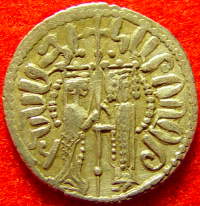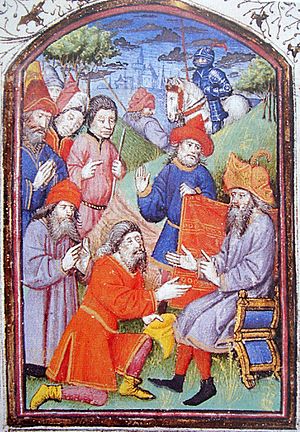Hethum I of Armenia facts for kids
Quick facts for kids Hethum IՀեթում Ա |
|
|---|---|

Hethum I with Queen Isabella on a coin
|
|
| King of the Armenian Kingdom of Cilicia | |
| Reign | 1226 – 1270 |
| Predecessor | Isabella |
| Successor | Leo II |
| Co-ruler | Isabella (1226 – 1252) |
| Born | 1213 |
| Died | 21 October 1270 (aged 56–57) |
| Spouse | Isabella |
| Issue | Euphemia Maria Sybille Rita Leo II Thoros |
| Dynasty | House of Lambron |
| Father | Constantine of Baberon |
| Mother | Princess Alix Pahlavouni of Lampron |
Hethum I (Armenian: Հեթում Ա; born in 1213, died October 21, 1270) was a powerful king. He ruled the Armenian Kingdom of Cilicia, sometimes called "Little Armenia," from 1226 to 1270. He was the son of Constantine of Baberon and Princess Alix Pahlavouni.
Hethum started a new royal family line known as the Hethumids. He made a very important decision to become an ally of the powerful Mongol Empire. Hethum even traveled all the way to the Mongol court in Karakorum, Mongolia. This journey was written about by his friend, the historian Kirakos Gandzaketsi. Hethum worked with the Mongols to fight against the Muslim Mamluks. He also encouraged other Christian states in the region to join this alliance.
Hethum's Royal Family
Hethum's father, Constantine, was a regent for the young Queen Isabella, Queen of Armenia. Isabella was first married to Philip. However, Constantine arranged for Philip to be removed from power. Instead, he made Isabella marry his own son, Hethum, on June 14, 1226. This made Isabella and Hethum co-rulers of the kingdom.
Hethum and Isabella had six children together:
- Leo II (who later became king)
- Thoros (who died in a battle against the Mamluks in 1266)
- Sibylla (who married Bohemond VI of Antioch)
- Euphemie (who married Julian Grenier, the Lord of Sidon)
- Rita of Armenia (who married Constantine of Servantikar)
- Maria (who married Guy of Ibelin)
Armenia and the Mongol Empire
Hethum was a key figure in the politics of the Crusader states. The Armenians had connections with many different groups. They were usually allied with European powers. However, during Hethum's rule, the Mongol Empire was growing very fast. This became a major concern.
When the Mongol commander Baiju attacked the Sultanate of Rum (a Turkish kingdom), their sultan, Kaykhusraw II, asked Hethum for help. Hethum decided to delay his help. He likely felt the Mongols were a bigger threat. The Mongols then defeated the Seljuqs badly at the Battle of Köse Dağ.
The Mongols then moved closer to Cilicia. King Hethum made a smart choice to accept Mongol suzerainty. This meant his kingdom would be under the protection and control of the Mongols. He sent his brother Sempad to the Mongol court in Karakorum. In 1247, Sempad met the Great Khan Güyük. They made a formal agreement. Cilician Armenia became a vassal state of the Mongol Empire.
In 1254, Hethum himself traveled through Central Asia to Mongolia. He wanted to renew this important agreement. He brought many valuable gifts. He met with Möngke Khan, Güyük's cousin. A member of Hethum's group, Kirakos Gandzaketsi, wrote about this amazing journey. His account is important because it describes Mongol, Buddhist, and Chinese culture, geography, and animals.
On his way back, Hethum visited the Mongol leader Baiju. He even saw Baiju's victory in Asia Minor against the Seljuq Turks.
Hethum strongly encouraged other Christian rulers to follow his lead. He wanted them to also become allies of the Mongols. His son-in-law, Bohemond VI of Antioch, was the only one who did so. Armenian troops fought alongside the Mongol army when they captured Baghdad in 1258. Both Armenians and soldiers from Antioch fought with the Mongol army under Hulagu. They helped capture Aleppo and Damascus in 1260.
However, in September 1260, the Egyptian Mamluks defeated the Mongols. This happened at the important Battle of Ain Jalut. The Mongols were pushed back across the Euphrates River. They would not control Syria again for a long time.
Hethum's Retirement
In the last years of Hethum's rule, his kingdom faced many attacks. This was largely because Hethum had actively supported the Mongols. The Mamluks, led by Baybars, invaded in 1266. The Armenian army was much smaller than the Mamluks. They could not stop them at the Battle of Mari. During this battle, one of Hethum's sons, Thoros, lost his life. Another son, Leo, was captured and put in prison.
After this defeat, several Armenian cities were attacked. These included Adana, Tarsus, and Ayas. The capital city of Sis was also attacked and damaged. Many Armenians were killed, and thousands were taken captive. Hethum was able to get his son Leo back by giving up some land to the Egyptians.
In 1270, Hethum decided to step down as king. He gave the throne to his son Leo. Hethum then spent the rest of his life in a monastery as a monk.
See also
 In Spanish: Haitón I de Armenia para niños
In Spanish: Haitón I de Armenia para niños


